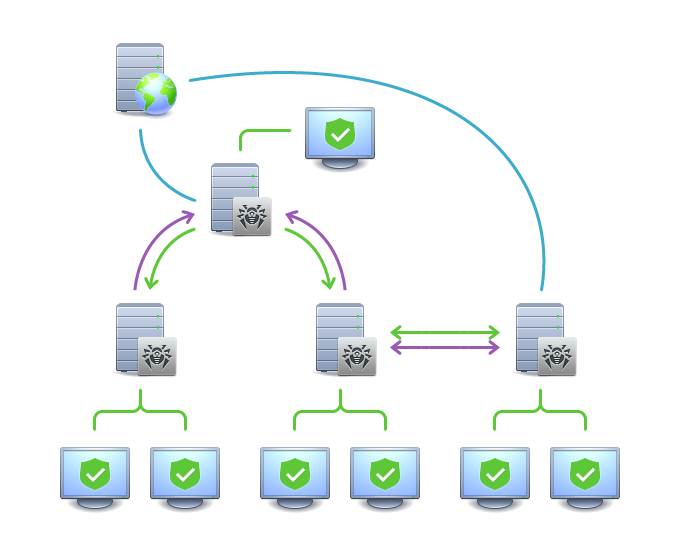Several Dr.Web Servers can be installed in an anti-virus network. Each Dr.Web Agent connects to one of them; each Dr.Web Server with connected anti-virus workstations functions as a separate anti-virus network as described in previous Chapters.
Dr.Web Enterprise Security Suite allows to connect such anti-virus networks by transferring data between Dr.Web Servers.
Dr.Web Server can send to another Dr.Web Server
•software and virus database updates (only one of them is to receive updates from Dr.Web GUS servers);
•information on events related to threats, statistics, etc.;
•licenses for protected stations (you can configure licenses propagation between Dr.Web Servers in the License Manager).
Dr.Web Enterprise Security Suite provides for two types of connections between Dr.Web Servers:
•a parent-child type of connection, where the principle Dr.Web Server transfers updates to the subordinate one and receives information about events,
•a peer to peer connection, where data types and transfer directions are set up individually.
An example of a multi-server structure is presented in the figure below.
|
Dr.Web Server |
|
TCP/IP network |
|
Protected computer |
|
Transfer of updates via HTTP |
|
Dr.Web GUS |
|
Sending information on events |
|
|
|
Interserver transfer of updates, licenses for stations |
A multi-server network
Some advantages of the anti-virus network with several Dr.Web Servers:
1.Receiving of updates from Dr.Web GUS servers by one principle Dr.Web Server and their subsequent distribution to other Dr.Web Servers directly or through intermediates.
Dr.Web Servers that receive updates from the superior Dr.Web Server, do not receive updates from GUS even if such task is set in the schedule. Still, in case the parent Dr.Web Server is inaccessible, it is recommended to keep the task for updating from the GUS on subordinate Dr.Web Servers. This allows Dr.Web Agents which are connected to the subordinate Dr.Web Server to receive updated virus databases and program modules (see also p. General Repository Configuration). |
In the task for updating from GUS on the superior Dr.Web Server propagating updates, you must set up the receiving updates of the Dr.Web Server software for all operating systems installed on all subordinate Dr.Web Servers, which receive updates from this superior Dr.Web Server (see p. General Repository Configuration). |
2.Distribution of workstations between several Dr.Web Servers, decreasing the load on each of them.
3.Consolidation of data from several Dr.Web Servers on one Dr.Web Server; the possibility to view all the data through Dr.Web Security Control Center connected to such Dr.Web Server.
Dr.Web Enterprise Security Suite anti-virus monitors and prevents the creation of cyclic data flows. |
4.Available licenses for protected stations can be donated to the neighbor Dr.Web Server. At this, the license key itself remains at the disposal of the distributing Dr.Web Server, available licenses are propagated to a neighbor Dr.Web Server for a specified time period and after it has expired, the licenses are revoked.
